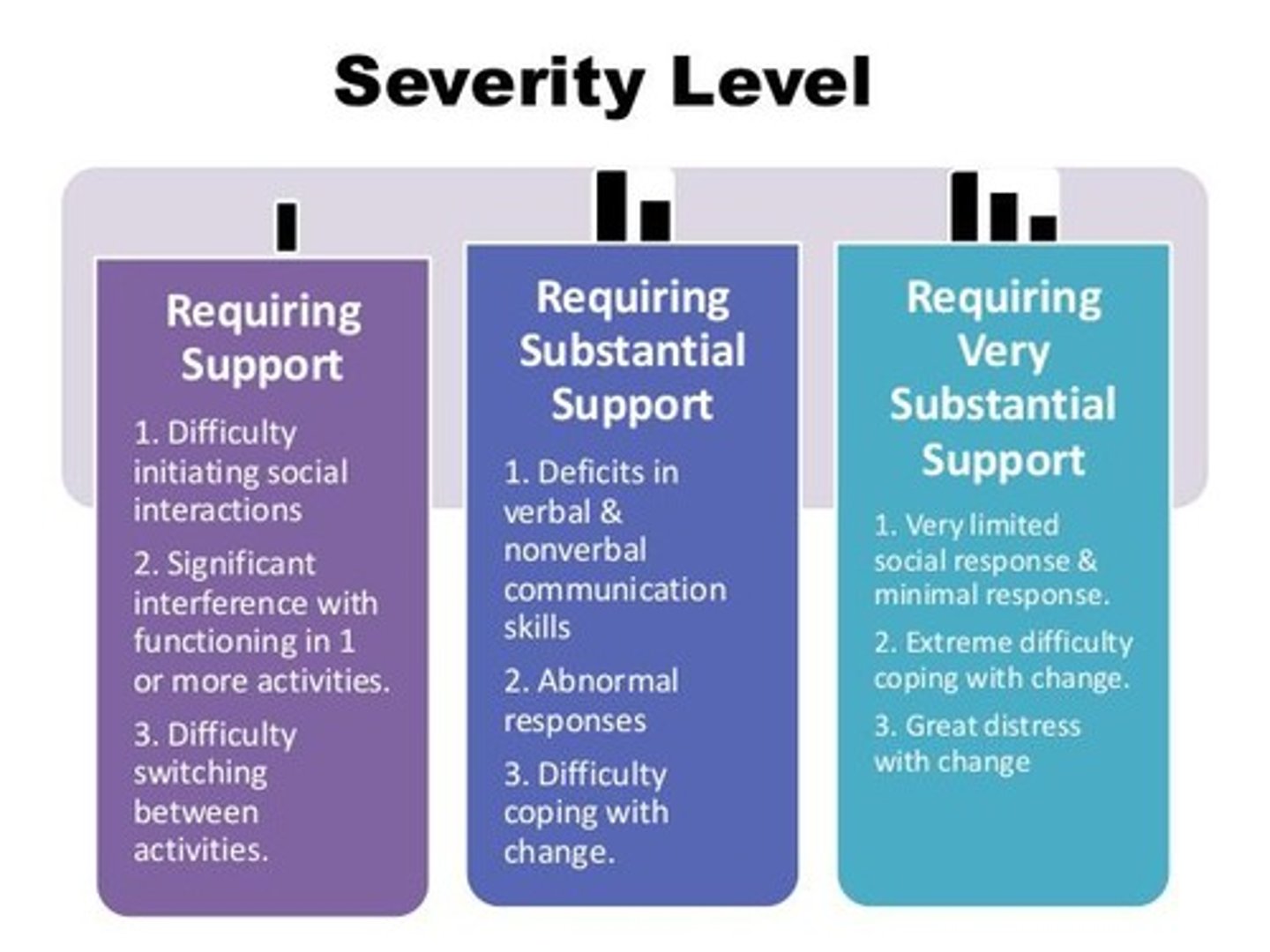Study Guide for Personality and Neurodevelopmental Disorders
1/179
There's no tags or description
Looks like no tags are added yet.
Name | Mastery | Learn | Test | Matching | Spaced |
|---|
No study sessions yet.
180 Terms
Personality
Complex characteristics outside awareness, shaped by experiences.
Personality Disorder
Enduring deviant patterns causing distress or impairment.
Prevalence of personality disorder
6-15% of population affected by personality disorders.
BPD
Borderline Personality Disorder, common in clinical settings.

ASPD
Antisocial Personality Disorder, prevalent in substance use clinics.
Big 5 personality traits
Openness, Conscientiousness, Extraversion, Agreeableness, Neuroticism.
Openness
Curiosity and openness to new experiences.
Conscientiousness
Organization, self-direction, and perseverance.
Extraversion
Need for activity and social interaction.
Agreeableness
Helpfulness, altruism, and empathy towards others.
Neuroticism
Emotional stability and regulation.
Metacognition
Understanding one's own thoughts and mental state.
Maladaptive Responses
Dysfunction in emotional regulation across diagnoses.
Impaired Identity
Incomplete identity formation affecting goals and relationships.
Impulsivity
Abrupt reactions leading to destructive behavior.
Self-Control
Ability to regulate one's own behavior and emotions.
Identity Integration
Coherent sense of self across different contexts.
Relational Capacities
Ability to form and maintain relationships.
Responsibility
Accountability for one's actions and decisions.
Social Concordance
Alignment with social norms and expectations.
Cluster A
Personality disorders characterized by odd or eccentric behavior.
Paranoid Personality Disorder
Mistrustful and suspicious, avoiding uncontrolled relationships.
Trustworthiness
Reliance on others without provocation or evidence.
Distortion of Reality
Misinterpreting minor issues as significant problems.
Self-Importance
Persistent belief in one's own significance.
Argumentative Behavior
Tendency to engage in disputes or conflicts.
Nurse-Client Relationship
Connection between healthcare provider and patient.
Mistrust in Patients
Difficulty in establishing trust with clients.
Schizoid Personality Disorder
Characterized by emotional aloofness and solitary habits.
Impaired Social Interaction
Difficulty engaging with others socially.
Introverted Behavior
Preference for solitary activities over socializing.
Aloofness
Emotional detachment or lack of interest in others.
Communication Confusion
Difficulty in maintaining focus during conversations.
Isolation Reduction Goals
Objectives to decrease patient loneliness and enhance enjoyment.
Schizotypal Personality Disorder
Social and emotional deficits with odd beliefs.
Ideas of Reference
Belief that common events have special significance.
Constricted Affect
Limited emotional expression or response.
Social Anxieties
Excessive fear or worry in social situations.
Eccentric Behavior
Unusual mannerisms or habits that alienate others.
Supportive Care
Nursing aimed at boosting self-esteem and worth.
Nursing Care for Schizotypal
Focus on social norms to reduce isolation.
Cluster A Disorders
Group of personality disorders characterized by odd behavior.
Paranoid Personality Disorder
Characterized by pervasive distrust and suspicion of others.
Schizotypal Personality Disorder
Characterized by eccentric behavior and social deficits.
Narcissistic Personality Disorder
Excessive self-love and need for admiration.
Grandiosity
Inflated sense of self-importance and entitlement.
Impaired Empathy
Difficulty understanding or caring about others' feelings.
Preoccupation with Success
Focus on money, beauty, and personal achievements.
Criticism Intolerance
Disproportionate reactions to criticism or judgment.
Cluster B
Personality disorders marked by dramatic behavior.
Avoidant Personality Disorder
Fear of embarrassment leads to social avoidance.
Social Rejection Fear
Intense anxiety about being rejected socially.
Comfort in Familiarity
Only feel safe in known social contexts.
Low Self-Esteem
Perception of incompetence and fear of criticism.
Family Relationships
Close ties with family, struggles with outsiders.
Trust Building
Takes time for patients to trust caregivers.
Positive Reinforcement
Support patients to recognize positive social interactions.
Dependent Personality Disorder
Extreme need for closeness, often detrimental.
Passive Behavior
Submissive tendencies to avoid conflict.
Decision-Making Difficulty
Struggle to make choices independently.
External Self-Esteem
Self-worth derived from others' opinions.
Adulting Distress
Difficulty managing adult responsibilities independently.
Assertiveness Training
Helps patients express needs and make decisions.
Obsessive-Compulsive Personality Disorder
Rigidity and perfectionism without distress from obsessions.
Control Preoccupation
Focus on orderliness and strict routines.
Non-Distressful Symptoms
Patients often do not see their behaviors as problematic.
Acceptance
Recognizing patient as a valuable individual.
Non-judgmental statements
Acknowledging lived experiences without criticism.
Honesty in interactions
Being truthful during patient communications.
Label behaviors
Identify actions without labeling individuals.
Direct questions
Ask caring, genuine inquiries to patients.
Encourage expression
Support sharing of thoughts and feelings.
Active listening
Engage fully to understand patient concerns.
Build hope
Foster optimism in patient outlook.
Disruptive disorders
Characterized by impulse control and conduct issues.
DSM-V
Diagnostic manual for mental health disorders.
Self-control problems
Challenges in managing emotions and behaviors.
Violating rights
Intrusive actions against others' personal boundaries.
Social norms conflict
Behavior that contradicts societal expectations.
Authority issues
Struggles with following rules and regulations.
Oppositional defiance disorder
Pattern of angry, irritable behavior towards authority.
Intermittent explosive disorder
Recurrent outbursts of extreme anger.
Conduct disorder
Persistent violation of societal norms and rights.
Kleptomania
Compulsive stealing without need or justification.
Pyromania
Compulsive fire-setting behavior.
Antisocial Personality Disorder
Pattern of disregard for others' rights.
Epidemiology of ASPD
Affects 2% to 3% of the population.
Childhood onset CD
Earlier onset linked to worse outcomes.
Adolescent onset CD
Later onset with different developmental implications.
Attachment issues
Problems stemming from early relationship disruptions.
Traumatic childhoods
Early adverse experiences influencing behavior.
Antisocial Personality Disorder (ASPD)
Pattern of antisocial behavior before age 15.
Psychopathic Traits
Not all ASPD individuals exhibit psychopathy.
Risk Factors for ASPD
Includes male gender and substance use disorder.
ADHD and ASPD
Difficult temperament increases ASPD risk.
Genetic Component of ASPD
Five times more common in first-degree relatives.
Intermittent Explosive Disorder (IED)
Characterized by disproportionate aggressive outbursts.
IED Outbursts
Can be verbal, physical, or both.
Duration of IED Episodes
Episodes last minutes to hours.
Consequences of IED
Impacts relationships, school, employment, and legal issues.